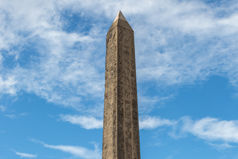Who owns it?
by Josh Ford
First of all, what exactly is ownership and how do we define it in today’s standards. That is a major question that often comes up when dealing with ancient artifacts. In CC Long’s article, Send Back the Obelisk, the main issue at hand examines the story of Cleopatra’s Needle. The enormous obelisk was taken from its native Alexandria and erected all the way around the world in New York. Long, who is most definitely if favor to repatriate the obelisk, strongly describes his memory of the obelisk in Egypt.
Seemingly, on the other side of this fence, James Cuno wrote Culture War: The Case Against Repatriating the Museum about the national origin of artifacts and the reasons why many want to see these objects return to their homeland.
Cleopatra’s Needle has a very interesting history that is as colorful as it is odd. Long imagines it from the doors of the Temple of the Sun at Heloiopolis to it standing at the Sebasteum in Alexandria where Cleopatra had it removed. this is such a beautiful image to me and I understand how people would want to see it back in situ. Long makes a very good point in that it has so much history where it is from.
In Egypt, people would appreciate it. They would understand it and live with it. However, I think the gigantic obelisk loses so much of its meaning and deep cultural impact in New York. I wonder how many people walk by it every day and do not know a thing about it. Long says it is meaningless here but would mean so much more if it was sent back to Egypt and I agree.
“An act of vandalism which may be justly likened to the theft of the Elgin Marbles from the Temple of Minerva”( Long 411). An act of vandalism indeed, how would we feel as Americans if someone broke away the President’s faces from Mount Rushmore to put them in a park in another country. It has no context in New York. Not only does it not make sense in New York, but it is not meant to withstand the weather there either. Long describes Cleopatra’s Needle as “fast crumbling away” and in need of a “heroic remedy” to stop the decay. What could be a better reason to send back an artifact than the place it lives is literally eating it away.
Even someone who seems to oppose repatriation, James Cuno, says many people use “ancient cultural objects to affirm continuity with a glorious and powerful past…” (Cuno 120). He then goes on to explain that they are using it to burnish their modern political image and that these arguments are protectionist claims on culture. More than a denial of cultural exchange, Cuno says repatriation is an argument against encyclopedic museums like the Met.
I can understand both sides of the argument. On one hand, I want to say that no matter what, the artifact should always eventually make it back to its homeland. On the other hand, Cuno makes a very good point about scholars having the right for the knowledge. The fact is that no one can make the decision for all artifacts. Every case is different, for example, the Rosetta Stone was found in Egypt and taken to Great Britain which has a law that forbids the repatriation of an artifact once in their custody. As difficult a decision it would be to make, I think that every country has the right and responsibility to try to regain their precious artifacts.
Citations
Cuno, James. Who owns antiquity?: museums and the battle over our ancient heritage. Princeton University Press, 2010.
Long, Chas Chaillé. “Send Back the Obelisk!.” The North American Review (1886): 410-413.

